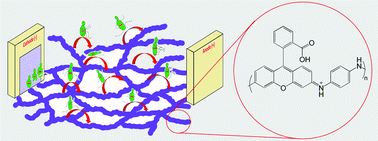Polyrhodamine: a redox stable conducting polyelectrolyte†
Abstract
Rhodamine dyes are known for their excellent photoluminescence properties but not commonly known for their electrical conductivity or redox stability. They are usually found as pendants (sidechains) attached to a variety of polymers but are not ordinary monomers for a polymer backbone. In this manuscript, we report on a new polymer containing the rhodamine core in the polymer backbone, polyrhodamine (PRho), and determine its optical and electrochemical properties. The polymer is soluble in polar solvents such as dimethyl sulfoxide and methanol, and partially soluble in water. The repeat units of PRho exist in various forms depending on the pH of the media, which also determines its photophysical properties. The absorption spectra for the acidic and basic forms show considerable overlap. The polymer is electrochemically reversible and stable up to 1000 cycles as recorded by cyclic voltammetry between −0.4 and 1.0 V vs. Ag/AgCl, as well as stable to extreme acidic and basic conditions without degradation. Remarkably, the polymer has a conductivity in the semiconductor range of 8.38 × 10−2 S cm−1 when treated with 20% HCl, which is the first report of a conductive polymer containing the rhodamine structure in the backbone.



 Please wait while we load your content...
Please wait while we load your content...